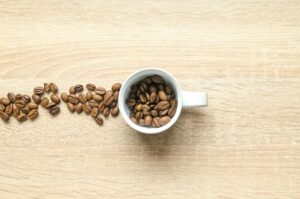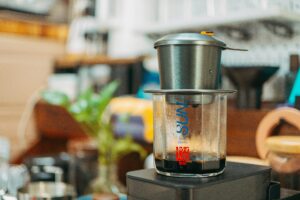Do you love the aroma of freshly ground coffee? For many, that first whiff of a freshly brewed cup is the highlight of their day. But to achieve that perfect cup, you need to master the art of grinding your coffee beans. Understanding how much coffee beans to grind can make all the difference between a mediocre cup and a spectacular one.
In this blog post, we will help coffee enthusiasts like you understand the nuances of grinding coffee beans. From determining the right amount to understanding different grind sizes, we’ve got you covered. By the end of this article, you will have a comprehensive guide on achieving the perfect grind for your favorite coffee.
The Importance of Grinding Coffee Beans
Grinding coffee beans is much more than a mechanical process. It’s an essential step that can make or break your coffee experience. When you grind coffee beans, you are increasing the surface area that comes in contact with water. This allows flavors and aromas to be extracted efficiently, resulting in a richer and more flavorful cup.
The grind size also plays a critical role in the extraction process. If the grind is too coarse, the water will pass through too quickly, leading to under-extracted coffee that tastes weak and sour. Conversely, if the grind is too fine, the water will pass through too slowly, resulting in over-extracted coffee that tastes bitter and harsh.
How Much Coffee Beans to Grind
One of the most common questions among coffee enthusiasts is, “How much coffee beans should I grind?” The answer depends on several factors, including the type of coffee you are making, the brewing method, and personal taste preferences.
The Golden Coffee-to-Water Ratio
The golden coffee-to-water ratio is a good starting point for determining how much coffee to grind. A general rule of thumb is to use one to two tablespoons of coffee per six ounces of water. This translates to approximately one gram of coffee per 15-18 grams of water. However, this ratio can be adjusted to suit your taste preferences. If you prefer a stronger cup, you can increase the amount of coffee, and if you prefer a milder cup, you can decrease it.
Factors Affecting Coffee Grind Amount
Several factors can influence the amount of coffee beans you should grind:
- Brewing Method: Different brewing methods require different grind sizes and coffee-to-water ratios. For example, French press coffee requires a coarse grind and a ratio of about one to fourteen, while espresso requires a fine grind and a ratio of about one to two.
- Bean Type: The type of coffee bean you are using can also impact the amount of coffee needed. Some beans are denser and more flavorful, requiring less coffee to achieve the desired strength.
- Personal Preference: Ultimately, the right amount of coffee to grind comes down to personal taste. Experimenting with different ratios and grind sizes will help you find the perfect balance for your palate.
Measuring Coffee Beans
To achieve consistency, it’s essential to measure your coffee beans accurately. Using a digital kitchen scale can help you get precise measurements. Simply weigh out the desired amount of coffee beans before grinding them. This ensures that you use the same amount each time, resulting in a consistent brew.
Different Grind Sizes for Various Brewing Methods
Understanding the different grind sizes and how they correspond to various brewing methods is crucial for achieving the perfect cup of coffee. Here’s a breakdown of the most common grind sizes and their ideal brewing methods:
Coarse Grind
A coarse grind has large, distinct particles similar to sea salt. This grind size is ideal for methods that require a longer extraction time:
- French Press: The coarse grind allows for a slow extraction process, resulting in a full-bodied and robust cup of coffee.
- Cold Brew: The large particles of a coarse grind work well for the extended brewing time required for cold brew, producing a smooth and mellow flavor.
Medium-Coarse Grind
A medium-coarse grind has slightly smaller particles than a coarse grind, resembling rough sand. It’s suitable for the following brewing methods:
- Chemex: The medium-coarse grind works well with the thick paper filters of the Chemex, allowing for a balanced extraction.
- Clever Dripper: This grind size provides an even extraction, resulting in a clean and flavorful cup.
Medium Grind
A medium grind has particles similar to granulated sugar and is one of the most versatile grind sizes. It’s suitable for:
- Drip Coffee Makers: The medium grind allows for a balanced extraction in automatic drip coffee makers, producing a well-rounded cup.
- Siphon Brewers: This grind size works well with siphon brewers, allowing for a smooth and aromatic coffee.
Medium-Fine Grind
A medium-fine grind has smaller particles than a medium grind, resembling fine sand. It’s ideal for:
- Pour-Over: The medium-fine grind provides an even extraction in pour-over methods like the Hario V60, resulting in a bright and clean cup.
- Aeropress: This grind size works well for the Aeropress, allowing for a short extraction time and a rich flavor.
Fine Grind
A fine grind has particles similar to table salt and is suitable for methods that require a short extraction time:
- Espresso: The fine grind allows for a quick and intense extraction, resulting in a concentrated and flavorful shot of espresso.
- Moka Pot: This grind size works well with the Moka pot, allowing for a strong and bold cup of coffee.
Extra Fine Grind
An extra fine grind has particles similar to powdered sugar and is suitable for:
- Turkish Coffee: The extra fine grind is essential for Turkish coffee, allowing for a smooth and velvety texture.
Tips for Grinding Coffee Beans
Grinding coffee beans may seem straightforward, but there are a few tips and tricks that can help you achieve the best results:
Use a Burr Grinder
A burr grinder is the best tool for grinding coffee beans as it provides a consistent grind size. Unlike blade grinders that chop the beans unevenly, burr grinders crush the beans between two abrasive surfaces, resulting in uniform particles.
Grind Just Before Brewing
For the freshest and most flavorful cup of coffee, grind your beans just before brewing. Coffee beans start to lose their flavor and aroma once they are ground, so it’s best to grind only what you need for each batch.
Experiment with Grind Sizes
Don’t be afraid to experiment with different grind sizes and brewing methods. Coffee is a personal experience, and finding the right combination of grind size, coffee-to-water ratio, and brewing method can take some trial and error.
Death Wish Coffee Whole Bean Dark Roast

- Extra Kick of Caffeine
- USA Organic Coffee Beans
- Fair Trade Arabica & Robusta Coffee Beans
- Dark Roast Coffee Beans
Storing Coffee Beans
Proper storage of coffee beans is essential for maintaining their freshness and flavor. Here are a few tips for storing your beans:
Use an Airtight Container
Store your coffee beans in an airtight container to protect them from air, moisture, and light. This will help preserve their flavor and aroma.
Keep Beans in a Cool, Dark Place
Coffee beans are sensitive to heat and light, so it’s best to store them in a cool, dark place. Avoid storing them in the refrigerator or freezer, as the temperature fluctuations can affect their quality.
Buy Fresh Beans
For the best flavor, buy fresh coffee beans in small quantities and use them within a few weeks of roasting. This ensures that you always have fresh beans on hand for grinding.
Common Mistakes to Avoid
Even seasoned coffee enthusiasts can make mistakes when it comes to grinding coffee beans. Here are a few common mistakes to avoid:
Using the Wrong Grind Size
Using the wrong grind size for your brewing method can result in a poor extraction and an unsatisfying cup of coffee. Make sure to match the grind size to your brewing method for the best results.
Over or Under Grinding
Grinding coffee beans too coarsely or too finely can affect the extraction process and the final flavor of your coffee. Experiment with different grind sizes to find the right balance for your taste.
Not Cleaning the Grinder
Coffee oils and residue can build up in your grinder over time, affecting the flavor of your coffee. Make sure to clean your grinder regularly to maintain its performance and the quality of your coffee.
FAQs About Coffee Grinding
How Fine Should I Grind Coffee Beans?
The grind size depends on your brewing method. For example, a coarse grind is suitable for French press, while a fine grind is ideal for espresso. Refer to the grind size guide provided in this article for more details.
Can I Use a Blender to Grind Coffee Beans?
While it’s possible to use a blender to grind coffee beans, it’s not recommended as it can result in an uneven grind. A burr grinder is the best tool for achieving a consistent grind size.
How Long Should I Grind Coffee Beans?
The grinding time depends on your grinder and the desired grind size. Burr grinders usually have settings for different grind sizes, so follow the manufacturer’s instructions for the best results.
Conclusion
Mastering the art of grinding coffee beans is essential for achieving the perfect cup of coffee. By understanding the importance of grind size, measuring the right amount of beans, and experimenting with different brewing methods, you can elevate your coffee experience to new heights. Remember to use a burr grinder, grind just before brewing, and store your beans properly to maintain their freshness and flavor.
Ready to take your coffee game to the next level? Start experimenting with different grind sizes and brewing methods today! And if you’re looking for more tips and tricks, check out our other coffee guides and resources. Happy brewing!






